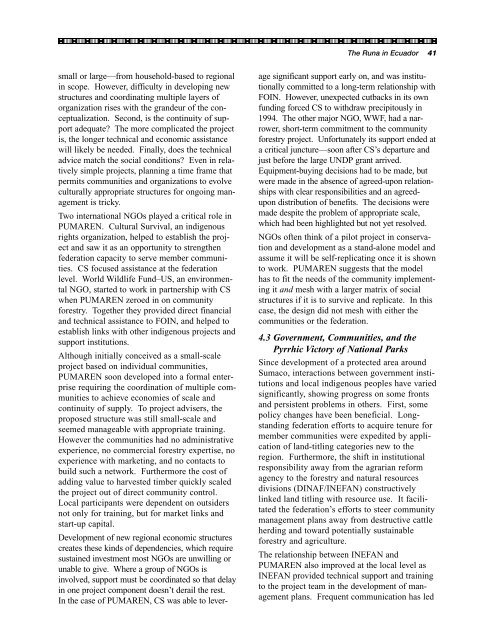Indigenous Peoples and Conservation Organizations
Indigenous Peoples and Conservation Organizations
Indigenous Peoples and Conservation Organizations
Create successful ePaper yourself
Turn your PDF publications into a flip-book with our unique Google optimized e-Paper software.
The Runa in Ecuador 41<br />
small or large—from household-based to regional<br />
in scope. However, difficulty in developing new<br />
structures <strong>and</strong> coordinating multiple layers of<br />
organization rises with the gr<strong>and</strong>eur of the conceptualization.<br />
Second, is the continuity of support<br />
adequate? The more complicated the project<br />
is, the longer technical <strong>and</strong> economic assistance<br />
will likely be needed. Finally, does the technical<br />
advice match the social conditions? Even in relatively<br />
simple projects, planning a time frame that<br />
permits communities <strong>and</strong> organizations to evolve<br />
culturally appropriate structures for ongoing management<br />
is tricky.<br />
Two international NGOs played a critical role in<br />
PUMAREN. Cultural Survival, an indigenous<br />
rights organization, helped to establish the project<br />
<strong>and</strong> saw it as an opportunity to strengthen<br />
federation capacity to serve member communities.<br />
CS focused assistance at the federation<br />
level. World Wildlife Fund–US, an environmental<br />
NGO, started to work in partnership with CS<br />
when PUMAREN zeroed in on community<br />
forestry. Together they provided direct financial<br />
<strong>and</strong> technical assistance to FOIN, <strong>and</strong> helped to<br />
establish links with other indigenous projects <strong>and</strong><br />
support institutions.<br />
Although initially conceived as a small-scale<br />
project based on individual communities,<br />
PUMAREN soon developed into a formal enterprise<br />
requiring the coordination of multiple communities<br />
to achieve economies of scale <strong>and</strong><br />
continuity of supply. To project advisers, the<br />
proposed structure was still small-scale <strong>and</strong><br />
seemed manageable with appropriate training.<br />
However the communities had no administrative<br />
experience, no commercial forestry expertise, no<br />
experience with marketing, <strong>and</strong> no contacts to<br />
build such a network. Furthermore the cost of<br />
adding value to harvested timber quickly scaled<br />
the project out of direct community control.<br />
Local participants were dependent on outsiders<br />
not only for training, but for market links <strong>and</strong><br />
start-up capital.<br />
Development of new regional economic structures<br />
creates these kinds of dependencies, which require<br />
sustained investment most NGOs are unwilling or<br />
unable to give. Where a group of NGOs is<br />
involved, support must be coordinated so that delay<br />
in one project component doesn’t derail the rest.<br />
In the case of PUMAREN, CS was able to leverage<br />
significant support early on, <strong>and</strong> was institutionally<br />
committed to a long-term relationship with<br />
FOIN. However, unexpected cutbacks in its own<br />
funding forced CS to withdraw precipitously in<br />
1994. The other major NGO, WWF, had a narrower,<br />
short-term commitment to the community<br />
forestry project. Unfortunately its support ended at<br />
a critical juncture—soon after CS’s departure <strong>and</strong><br />
just before the large UNDP grant arrived.<br />
Equipment-buying decisions had to be made, but<br />
were made in the absence of agreed-upon relationships<br />
with clear responsibilities <strong>and</strong> an agreedupon<br />
distribution of benefits. The decisions were<br />
made despite the problem of appropriate scale,<br />
which had been highlighted but not yet resolved.<br />
NGOs often think of a pilot project in conservation<br />
<strong>and</strong> development as a st<strong>and</strong>-alone model <strong>and</strong><br />
assume it will be self-replicating once it is shown<br />
to work. PUMAREN suggests that the model<br />
has to fit the needs of the community implementing<br />
it <strong>and</strong> mesh with a larger matrix of social<br />
structures if it is to survive <strong>and</strong> replicate. In this<br />
case, the design did not mesh with either the<br />
communities or the federation.<br />
4.3 Government, Communities, <strong>and</strong> the<br />
Pyrrhic Victory of National Parks<br />
Since development of a protected area around<br />
Sumaco, interactions between government institutions<br />
<strong>and</strong> local indigenous peoples have varied<br />
significantly, showing progress on some fronts<br />
<strong>and</strong> persistent problems in others. First, some<br />
policy changes have been beneficial. Longst<strong>and</strong>ing<br />
federation efforts to acquire tenure for<br />
member communities were expedited by application<br />
of l<strong>and</strong>-titling categories new to the<br />
region. Furthermore, the shift in institutional<br />
responsibility away from the agrarian reform<br />
agency to the forestry <strong>and</strong> natural resources<br />
divisions (DINAF/INEFAN) constructively<br />
linked l<strong>and</strong> titling with resource use. It facilitated<br />
the federation’s efforts to steer community<br />
management plans away from destructive cattle<br />
herding <strong>and</strong> toward potentially sustainable<br />
forestry <strong>and</strong> agriculture.<br />
The relationship between INEFAN <strong>and</strong><br />
PUMAREN also improved at the local level as<br />
INEFAN provided technical support <strong>and</strong> training<br />
to the project team in the development of management<br />
plans. Frequent communication has led

















